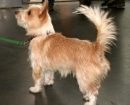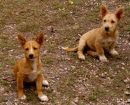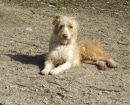Content |
|---|
History
The Portuguese Podengo It is considered one of the oldest dogs breeds, that has its origins in the Phoenicians, cultural matrix of which descend the Portuguese. It is a native breed of Portugal, with great skills for hunting, but also surveillance, It is commonly used on farms to alert of the presence of intruders.
The great family of the hound race, specialists in the topic raised it was in Portugal where most subjected to crossing and as a result, branched lineage. Within their ancestors argue that perhaps the closest the Ibizan Hound, and various types of dogs of traces of lived (They inhabit) throughout the Mediterranean area. Like all hound dogs, History shows that they are represented in Egyptian paintings of thousands of years ago.
according to size, There are three varieties of Portuguese Hound, Grand, Small and medium, being each variety, products of the different crossing, over time.
It is believed that the great variety has emerged the variety of Portuguese Podengo small and medium, the ancestor of the Grande variety is the Pharaoh Hound spread from North Africa to the Iberian Peninsula. Although other authors raise that it is possible that the hound descends from the small Iberian wolves. There is still controversy...
Although one of the theories suggests that the Medium Portuguese Podenco arises, of different Podenco dogs from North Africa, The most accepted theory is that this variety, directly descended from the Portuguese Podengo Grande.
The small Portuguese Hound, sometimes described as a Chihuahua heavier (There is no kinship between these two races), often collaborate in the tasks of hunting with their larger peers, what this dog does is get into the rabbit hole and scare them so that they come out and are hunted by their pack mates.
In the North of Portugal today it is still used for hunting rabbits and small vermin. Hunting in a pack or alone. Although this dog can be seen in the rest of the country, its popularity lies in the North of the same.
Physical characteristics
As specified above, according to size, There are three varieties of Portuguese Hound, Grand, Medium- and Petit:
- Portuguese Podengo Grande: It is a very rare variety and is in danger of extinction, especially the smooth variety. They are usually used in packs to hunt large prey such as deer or wild boar.. It is the only Portuguese breed used for wild boar hunting. His cloak can be short and smooth (less common and on the verge of extinction) or rough and long.
- Portuguese Podengo Medio: It is the fastest of the three varieties, excellent Hunter of rabbits and hares. You can hunt in a pack or alone. Like the great Portuguese Hound, their coats can be smooth or rough and short and long. Of the three varieties this is the most common, and the greatest concentration of these dogs is located in the North of Portugal.
- Portuguese Podengo Pequeno: Like his brother medium is an excellent Hunter of rabbits and hares. Responsible for getting into the Burrows (Thanks to its size and agility) to drive away prey and be hunted down by his pack mates. The small Portuguese Podengo coat is short and smooth, only.
The varieties in the fur are related to the inclement weather and adaptation to the same, the smooth-haired variety is more common in northern Portugal, characterized by being a humid area, This soft and smooth coat is necessary because it is dried more easily after wet.
The variety of hair bristles found in drier areas, where the coat of hair has the function of protecting the dog from the sun's rays and cold weather in winter. Nature is wise…
The hair short or long, thick medium and bright. In dogs with long hair and rough, the hairs of the snout are long (Beard). The predominant colors are yellow and the fawn (with its varieties of color clear, to very dark), and diluted or matte black; unicolores with or without white spots or white spotting.
Their life expectancy is around the 12 or 14 years, and it is a race that is rarely seen outside Portugal.
In general, is a medium-sized dog, well proportioned, muscular with good bone structure. It has long, narrow head, with moderately wide skull and the pointed snout.
The ears, large and triangular, they are carried erect. It has eyes expressive and little bulging in orbits, color honey or brown, according to coat color.
The pigmentation of eyelids is darker that the of the fur. The body is quite long, with ribs moderately arched.
The tail, is strong and pointed, long and medium length, It is held horizontal or slightly arched in activity.
Character and skills
The Portuguese Podengo, It is their three varieties has a cheerful character, intelligent and very sociable with other dogs. They are extremely affectionate with their owners, especially with the children.
They are very shy with strangers, always alert and constant surveillance of their territory, that makes them good guard dogs, although, It lacks the aggressiveness which may show a watchdog or defence.
Observations
Unfortunately, the Portuguese Podengo It is one of the canine breeds that today are found in danger of extinction, even in Portugal. It is not easy to see them out of Portugal.
Images “Portuguese Podengo”
Videos “Portuguese Podengo”
Type and recognitions:
- FCI CLASSIFICATION: 94
- Group 5: Spitz and primitive types
- Section 7: Primitive type - Hunting Dogs. Without working trial..
Federations:
- – FCI – Group 5: Spitz-type dogs and primitive type – Section 7: Primitive type - Hunting Dogs. ⓘ
FCI breed standard "Portuguese Podengo"
Alternative names:
1. Portuguese Warren Hound (English).
2. Podengo portugais, Lévrier portugais (French).
3. Podengo Português (German).
4. Cão-coelheiro (Portuguese).
5. Podengo português (español).













 Podengo Portugues.Autumn Viamonte.
Podengo Portugues.Autumn Viamonte. Sammi the Portuguese Podengo
Sammi the Portuguese Podengo Portuguese Podengo Pequeno Larry
Portuguese Podengo Pequeno Larry < a rel = "#voverlay" href = "http://translate.googleusercontent.com/translate_c?depth=1 & hl = it & prev=/search?q=Canarian+Warren+Hound+undercoat&client=firefox-a&rls=org.mozilla:it:official&biw=1920&bih=967 & rural = translate. google. it & sl = in & u = http://www.youtube.com/v/tvJtFcHHdC8?autoplay=1&rel=0&enablejsapi=1&playerapiid=ytplayer & usg=ALkJrhhsZNZ7stC4O8YT0YAzsx4N68SqcQ" title="Podengo portugais half sucht im Atlantik"> Podengo portugais half sucht im Atlantik "
< a rel = "#voverlay" href = "http://translate.googleusercontent.com/translate_c?depth=1 & hl = it & prev=/search?q=Canarian+Warren+Hound+undercoat&client=firefox-a&rls=org.mozilla:it:official&biw=1920&bih=967 & rural = translate. google. it & sl = in & u = http://www.youtube.com/v/tvJtFcHHdC8?autoplay=1&rel=0&enablejsapi=1&playerapiid=ytplayer & usg=ALkJrhhsZNZ7stC4O8YT0YAzsx4N68SqcQ" title="Podengo portugais half sucht im Atlantik"> Podengo portugais half sucht im Atlantik "